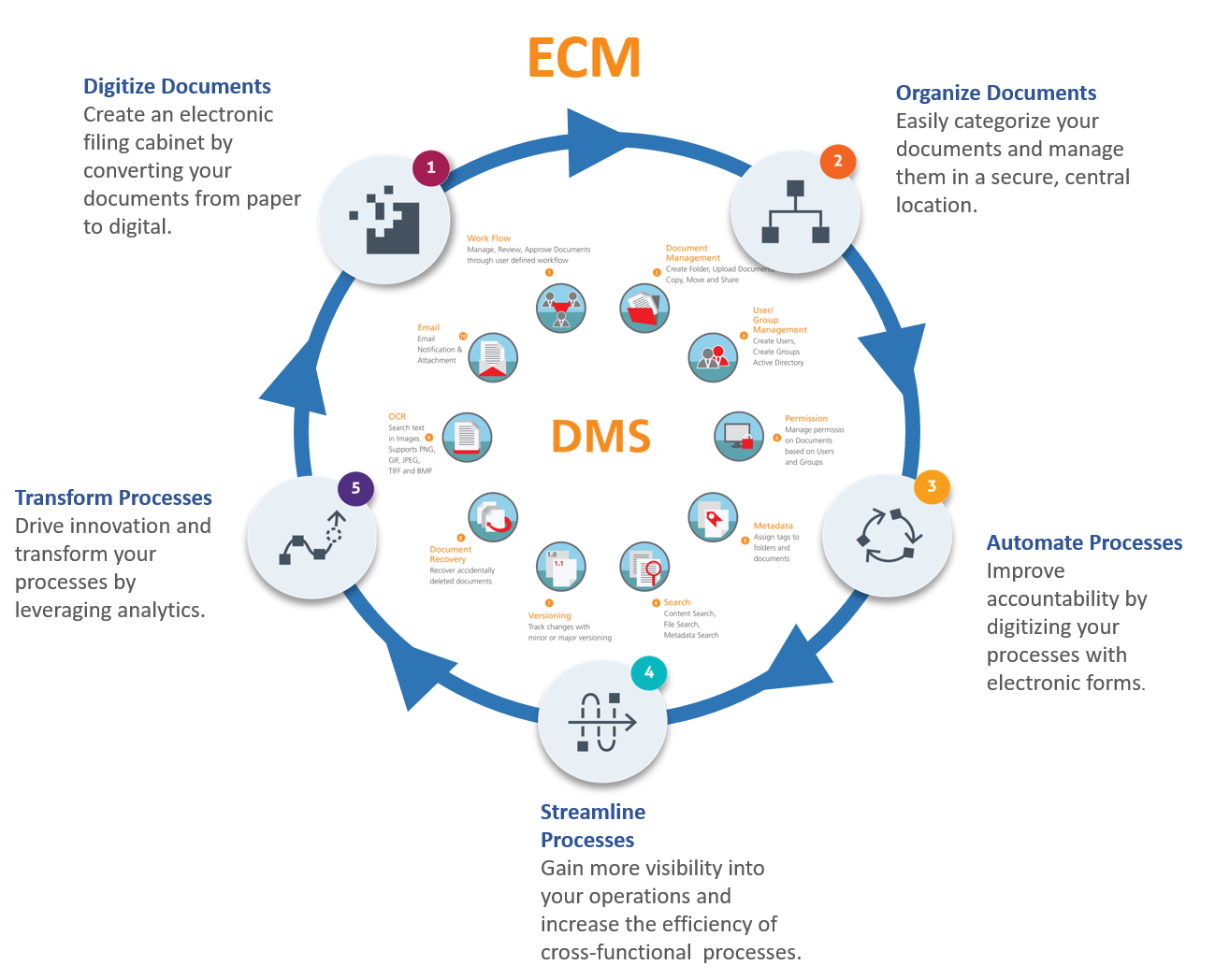Enterprise Content Management - Application Examples
Enterprise content management (ECM) is a collection of specified procedures, strategies, and technologies that enable a company to efficiently gather, organize, store, and provide vital information to its workers, business stakeholders, and consumers.
ECM has swiftly changed as new types of content have been brought into the workplace. Here are some examples of applications that can be provided by enterprise content management services.
Digitization
Digitization is the process of converting analogue information, such as paper documents and photo prints, into a digital version.
Many firms are deploying Enterprise Content Management systems to replace paper-based offices with paperless digital ones to save expenses, streamline processes, and save time.
For example, consider a company with several thousand employees that keeps all human resources (HR) documentation in paper files, beginning with job descriptions and resumes for new hires and progressing through performance reviews, financial and medical information, and severance or retirement documents.
Keeping this information on paper presents several challenges:
- Inadequate security (anyone with the key to the filing cabinet can access it)
- Access is slow, especially when actual papers are held off-site.
- It is time-consuming to distribute and update
- Subject to total devastation in the event of a fire or flood
- Misfiling is common - according to Gartner, 25% of improperly filed papers will never be found.
- Zero cooperation – just one person may work on the actual paper document at any given moment.
Digitization may significantly reduce the quantity of paper in a business, enhance efficiency, provide remote access, and expedite the digital transformation strategy.
Document Management
Consider enterprise document management systems to be tools that enable organizations to go beyond simply storing content to effectively searching and organizing it.
Building on digitization activities, the document management system provides more advanced storage capabilities than digitization while also managing, tracking, and retrieving content via features such as document version control, security and access management, and audit trails.
Consider a team producing and working on a project proposal as a real-world example of a document management tool.
Document management not only allows several users to update the proposal at the same time but also guarantees that modifications do not overwrite one another, ensuring a single source of truth at all times.

Case Management
While digitization and document management are focused on documents, corporate case management systems focus on a little more sophisticated aspect – the case.
A case is a collection of connected papers and information about a single entity, such as a patient, a court case, or a planning proposal.
Case management allows for the handling of that case as a single, collected entity and provides a single user interface to allow all actions and processes to be done on that case from one location.
For example, a client of an insurance company may be involved in a vehicle accident and make a claim.
An insurance case manager builds a case containing paperwork, police records, accident images, medical reports, signed affidavits, repair quotations, and any other important data to guarantee the client obtains the right medical treatment and reimbursement.
To deliver the most effective solutions and services, the caseworker must be able to access all information from the case unit on a single page when required, which is where an ECM's case management feature comes into play.
Knowledge Management
The process of creating, accumulating, structuring, storing, and sharing knowledge, experiences, and information within an organization is known as knowledge management.
It provides companies with a competitive advantage by boosting efficiency and decision-making abilities while also developing a well-informed, collaborative workforce beginning with the onboarding phase.
A customer support help desk is an example of an ECM knowledge management application. When a client contacts or sends a ticket, the support team must resolve the issue as fast as possible, especially because companies that excel at customer experience beat their competitors by an average of 80%.
The support representative can use a knowledge management system to locate the customer's file and review notes from previous calls.
The system can then deliver information related to the current problem, such as manuals, product videos, the most recent company news or policy changes, and any other relevant information that will assist them in quickly and efficiently resolving the problem.

Governance and Compliance
Noncompliance with government and industry laws may result in significant financial fines, business disruption, ruined reputations, and, in certain cases, jail terms in regulated areas such as healthcare, pharmaceutical, and energy.
ECM solutions provide capabilities such as Records Management (RM), retention management, destruction, eDiscovery, and audit trails to assist enterprises in meeting governance and compliance laws.
In the healthcare industry, for example, HIPAA Retention Requirements state that records must be kept for a minimum of six years from the day they were prepared.
An administrator can use a secure content management system to specify the retention duration on a document at the creation level to keep it safe until its automatic destruction, allowing for less audit and database bulk, as well as a lower chance of fines.
The Bottom Line
Whether your company is interested in digitalization, automation, optimizing business operations, compliance, document retention, and destruction, or building a more unified culture, enterprise content management services can provide a significant competitive advantage.
News & Events
Keep up to date
- 18Dec
Ricoh recognised as a Top 5 global AV Integrator in SCN Top 50 Systems Integrators 2025
- 11Dec
Ricoh Recognised as a Sustainability Leader in Quocirca's 2025 Report
- 31Oct
Ricoh perovskite solar cells installed on Japan Aerospace Exploration Agency cargo transfer spacecraft1 HTV-X1
- 17Oct
Ricoh recognised among Forbes’ World’s Best Employers 2025
